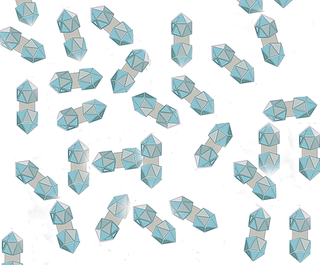Viroids are small single-stranded, circular RNAs that are infectious pathogens. Unlike viruses, they have no protein coating. All known viroids are inhabitants of angiosperms, and most cause diseases, whose respective economic importance to humans varies widely. A recent metatranscriptomics study suggests that the host diversity of viroids and other viroid-like elements is broader than previously thought and that it would not be limited to plants, encompassing even the prokaryotes.

Theodor Otto Diener was a Swiss-American plant pathologist. In 1971, he discovered that the causative agent of the potato spindle tuber disease is not a virus, but a novel agent, which consists solely of a short strand of single-stranded RNA without a protein capsid, eighty times smaller than the smallest viruses. He proposed to name it, and similar agents yet to be discovered, viroids. Viroids displaced viruses as the smallest known infectious agents.
Luteoviridae was a family of viruses. The family was abolished in 2020 based on evidence that its three genera and seven species unassigned to a genus belonged to two other, existing families.

Potyvirus is a genus of positive-strand RNA viruses in the family Potyviridae. Plants serve as natural hosts. Like begomoviruses, members of this genus may cause significant losses in agricultural, pastoral, horticultural, and ornamental crops. More than 200 species of aphids spread potyviruses, and most are from the subfamily Aphidinae. The genus contains 190 species and potyviruses account for about thirty percent of all currently known plant viruses.
Potato yellow dwarf virus (PYDV) is a plant virus of order Mononegavirales, family Rhabdoviridae and genus Alphanucleorhabdovirus. The virus was first identified in 1922 in the US by Barrus and Chupp (1922) who reported a new virus that was killing potatoes. The virus is known for its various effects on potato plants including stunted growth, dwarfing and apical yellowing. The virus also affects the tuber as it causes cracking and malformation. The virus is transmitted by the insect vector Agallia constricta. The insect becomes infected upon feeding on an infected plant and transmits the virus to every plant it feeds upon after this event.

Potato leafroll virus (PLRV) is a member of the genus Polerovirus and family Solemoviridae. The phloem limited positive sense RNA virus infects potatoes and other members of the family Solanaceae. PLRV was first described by Quanjer et al. in 1916. PLRV is transmitted by aphids, primarily the green peach aphid, Myzus persicae. PLRV is one of the most important potato viruses worldwide but particularly devastating in countries with limited resources and management. It can be responsible for individual plant yield losses of over 50%. One estimate suggests that PLRV is responsible for an annual global yield loss of 20 million tons. Symptoms include chlorosis, necrosis and leaf curling.
Andean potato mottle virus (APMoV) is a plant pathogenic virus of the family Comoviridae.
Potato aucuba mosaic virus (PAMV) is a plant pathogenic virus of the family Alphaflexiviridae.
Potato black ringspot virus (PBRSV) is a plant pathogenic virus of the family Comoviridae.
Potato virus A (PVA) is a plant pathogenic virus of the family Potyviridae.
Potato virus S (PVS) is a plant pathogenic virus. It was first reported in Netherlands. PVS causes mild or no symptoms in most potato varieties. It is common in potatoes in many regions and does not cause significant yield losses. Field-grown potatoes are not routinely screened for this virus because it is not considered economically important. However, PVS often present in mixed infections with other potato viruses, which may accentuate symptom severity.
Potato virus X (PVX) is a plant pathogenic virus of the family Alphaflexiviridae and the order Tymovirales.
Potato virus Y (PVY) is a plant pathogenic virus of the family Potyviridae, and one of the most important plant viruses affecting potato production.
Sweet potato feathery mottle virus (SPFMV) is a member of the genus Potyvirus in the family Potyviridae. It is most widely recognized as one of the most regularly occurring causal agents of sweet potato viral disease (SPVD) and is currently observed in every continent except Antarctica. The number of locations where it is found is still increasing; generally, it is assumed that the virus is present wherever its host is. The virus has four strains that are found in varying parts of the world.
Sweet potato latent virus (SPLV), formerly designated as sweet potato virus N, was first reported from Taiwan. The virus has flexuous, filamentous particles of approximately 700-750 nm long and induces typical cylindrical inclusion proteins in the cytoplasm of infected cells. The experimental host range of SPLV is wider than that of sweet potato feathery virus (SPFMV), and it induces symptoms on some Chenopodium and Nicotiana species. SPLV is serologically related to, but distinct from SPFMV. Sequence comparison of the 3’-partial sequences showed that SPLV was a distinct species of the genus Potyvirus in the family Potyviridae. The virus is common in China and has also been found in Korea and Rwanda.
Sweet potato mild mottle virus (SPMMV) is a plant pathogenic virus of the family Potyviridae.
Sweet potato yellow dwarf virus (SPYDV) is a plant pathogenic virus of the family Potyviridae.

Carlavirus, formerly known as the "Carnation latent virus group", is a genus of viruses in the order Tymovirales, in the family Betaflexiviridae. Plants serve as natural hosts. There are 53 species in this genus. Diseases associated with this genus include: mosaic and ringspot symptoms.

Sweet potato leaf curl virus is commonly abbreviated SPLCV. Select isolates are referred to as SPLCV followed by an abbreviation of where they were isolated. For example, the Brazilian isolate is referred to as SPLCV-Br.

Solemoviridae is a family of non-enveloped, positive-strand RNA viruses which infect plants. Solemoviridae is a member of the order Sobelivirales.
This page is based on this
Wikipedia article Text is available under the
CC BY-SA 4.0 license; additional terms may apply.
Images, videos and audio are available under their respective licenses.





